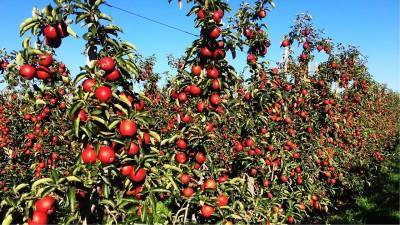KASHMIR, 9 April 2024: Apples, with their crisp texture and refreshing sweetness, hold a special place in the hearts of many Indians. From the iconic "apple a day" adage to featuring prominently in various desserts, this versatile fruit enjoys immense popularity across the country.
But where exactly do these apples originate? Let's embark on a journey to discover the leading apple-producing states in India for the year 2022-23, along with their estimated production figures.
Jammu and Kashmir: The Undisputed Apple King
Jammu and Kashmir emerges as the undisputed champion of apple production in India for 2022-23. This state, nestled amidst the majestic Himalayas, boasts ideal climatic conditions for apple cultivation. Cool summers and long, snowy winters provide the perfect environment for these fruit trees to thrive. Jammu and Kashmir is estimated to have contributed a staggering 17 lakh tonnes (1.7 million metric tons) of apples to the national production in 2022-23, translating to roughly 75% of the total output. The state is renowned for its exquisite apple varieties like Kashmir Eagle, Red Delicious, Golden Delicious, and Ambri, known for their unique flavors and vibrant colors.
Himachal Pradesh: The "Apple State" Lives Up to its Name
Following closely behind Jammu and Kashmir is Himachal Pradesh, another major player in India's apple production scene. Often referred to as the "Apple State" of India, Himachal Pradesh is blessed with fertile valleys and a temperate climate, making it ideal for apple cultivation. The state is estimated to have contributed approximately 6.4 lakh tonnes (0.64 million metric tons) of apples in 2022-23, accounting for roughly 20% of the national output. Himachal Pradesh is known for its delicious apple varieties like Royal Delicious, Granny Smith, and Sharmaji, prized for their excellent quality and long shelf life.
Uttarakhand: Emerging as a Promising Apple Producer
The Himalayan state of Uttarakhand is rapidly emerging as a significant contributor to India's apple production. With its favorable climate and dedicated efforts by farmers, Uttarakhand is estimated to have produced around 0.65 lakh tonnes (0.065 million metric tons) of apples in 2022-23, accounting for roughly 2.5% of the national output. The state is particularly known for its delicious varieties like Red Fuji and Sun Delicious, gaining popularity for their unique taste and attractive appearance.
A Tapestry of Flavors: Other Notable Apple Producing States
While Jammu and Kashmir, Himachal Pradesh, and Uttarakhand hold the top positions, several other Indian states contribute to the national apple basket:
Arunachal Pradesh: This northeastern state, with its high-altitude regions, holds immense potential for apple cultivation. Arunachal Pradesh is estimated to have produced around 7,340 tonnes (0.00734 million metric tons) of apples in 2022-23.
Nagaland: This hilly state in the northeast is known for its indigenous apple varieties. Nagaland is estimated to have produced a modest amount of apples in 2022-23, contributing to the national diversity of apple offerings.
Hill Regions of North India: States like Uttar Pradesh, Jammu and Kashmir (hills), and Himachal Pradesh (hills) also contribute to apple production, although the exact figures for these specific regions are often not readily available.
Factors Contributing to Apple Production Success
Several key factors contribute to the success of these leading apple-producing states
Climate: Cool summers with average temperatures between 20-25°C and long, cold winters with sufficient snowfall are crucial for successful apple cultivation. These conditions are prevalent in the Himalayan regions, making them ideal for apple orchards.
Soil: Well-drained, fertile soil with a slightly acidic pH is essential for optimal apple tree growth. The leading apple-producing states are blessed with such lands, providing the necessary nutrients for healthy fruit development.
Government Initiatives: The Indian government has implemented various initiatives to promote apple production, including providing subsidies for setting up orchards, training programs for farmers on advanced cultivation techniques, and promoting research and development of new apple varieties.
Expertise and Skills of Farmers: Generations of experience in apple cultivation have honed the skills of farmers in these regions. This expertise, coupled with the adoption of modern farming practices, contributes significantly to high yields and premium quality apples.
Challenges Faced by Apple Farmers
Apple farmers face a number of challenges, both from the environment and the marketplace. Here are some of the biggest:
Climate change: A changing climate can disrupt the delicate balance that apple trees need to thrive. Warmer temperatures can lead to earlier flowering, which can then be damaged by frost. Changes in rainfall patterns can also stress trees and make them more susceptible to disease.
Pests and diseases: Apple trees are susceptible to a number of pests and diseases, including codling moth, apple scab, and fire blight. These can damage crops and reduce yields.
Labor shortages: Finding qualified workers to pick apples can be a challenge, especially in remote areas. This can lead to higher labor costs and difficulty getting the harvest in on time.
Competition: Apple farmers face competition from other countries, such as China and Chile. These countries may have lower labor costs or be able to grow apples year-round.
Market fluctuations: The price of apples can fluctuate depending on the size of the crop and consumer demand. This can make it difficult for farmers to plan their finances.
Aging orchards: Many apple orchards are aging, and the trees are becoming less productive. This can lead to lower yields and higher costs for farmers.
Researchers are working on developing new varieties of apple trees that are more resistant to pests and diseases, and that can tolerate a wider range of climatic conditions. They are also looking at ways to improve storage and transportation techniques so that apples can be shipped longer distances without spoiling.




















